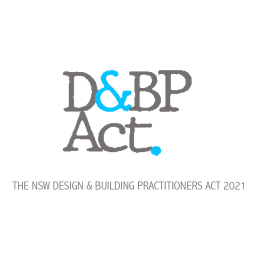
The NSW Government’s new Building Practitioners Act and in particular, the DBP Act [Design & Building Practitioner], has now been finalised as a new construction reform strategy has been set into motion. You can find it here.
Fronted by the Building Commissioner, David Chandler OAM, a new attempt at controlling the recent and endemic catastrophic build quality of developer driven housing projects across NSW, various “guidelines” have now been drafted to assist in the implementation of mitigating this problem of defecting building work, controlled by a NSW Taskforce, that will affect the way all architects, design + engineer professionals work and apportion liability.
The Act & Regulation has come into effect 1 July 2021.
The DBP Act will apply to all Class 2 buildings that have not commenced construction before 1 July 2021 (whether a CC has been issued or not).
This means that all Class 2 buildings will now be “Regulated Designs” and require registered “Design Practitioners” to provide “Design Compliance Declarations” before Construction can commence, and this declaration will be certifying that the design is in accordance with the Development Consent (DA) and the Building Code of Australia (BCA).
It means our scope of work and responsibility has expanded to include BCA Consultants, Disabled Access Consultants, Acoustic Engineers, Landscape Architects, Interior Designers, and the like as they will not be registered under the new regulations. We, as Architects, will need to check their work and provide Compliance Declarations for their work and take on their liability.
Any departures or ‘change of design’ from the DA will require these modifications to be approved by council under a S4.55 (including changes to finishes and changes required in order to comply with BCA).
There is also a requirement that a CC cannot be issued until all of the required documents have been provided and early works cannot commence until the whole building has been fully documented and documents declared ready for construction.
The responsibility for obtaining and lodging all of these documents appears to rest with the Principal Design Practitioner, with the clumsy and problematic NSW Planning Portal being central to the process of obtaining CC, lodging Declared Designs, applications for OC, etc.
CLIENT + PROJECT CONSEQUENCES:
- The developer/client will need to make sure that he engages architects and designers to undertake a new level of design ahead of any construction commencing on site. The days of construct and design are over and from here on, they will need to make good decisions about these engagements. There will be consequences for making bad appointments. They will need to look to best practice because just meeting previous minimum standards will not provide adequate risk management to avoid the cost of non-functional work having to be performed again. Developers are now held responsible to deliver buildings that meet the expectations of higher quality standards and of their purchasers. They must be seen to be trustworthy. The commissioner will be seeking out poor builders/developers and making an example of them with prohibition orders and a rating system.
- As the responsible architects making the “Design Compliance Declarations” we will now only work with consultants that we have had an ongoing and a trusted relationship with their standard of services.
- The client will now require a BCA consultant to provide a detailed “Compliance Capability” report at Design & DA stage.
- It will be advisable to engage a QS from design onset as any value/cost management after DA or CC approval will now require a S4.55 application.
- You will be required to also engage Registered Design Practitioners for certain parts of the design.
- a minimum level of documentation will be prescribed by the guidelines that will apply to architects and all other registered design professionals. These minimum requirements will be increasing the traditional scope of both a DA and a CC.
- All registered professionals are therefore reviewing their fee proposals to cater for this increased scope of work, and uncertainty around complexity of declarations, liability & portal lodgements. We anticipate that fees for documentation will increase by 50% and that a significant amount of hourly rate work will be required to navigate the portal’s complexity and satisfy the PCA.
In my mind, it’s been a long time coming and basically complements the initiatives of SEPP 65 and the ADG, which were brought into play by former Premier Bob Carr in the early 2000’s to combat an earlier and similar decadence and loss of urban design quality and placemaking, towards the end of the last century, that saw councils being completely outplayed and bullied by opportunistic developers.
Now it’s the build quality and integrative construction methodology that will need to align to that design excellence that SEPP 65 had tried to advance, and to make developers accountable for the quality of the product they offer.
I personally am quite excited with this reform as it feels a bit like a ‘back to the future’ moment by reinstating the architect in a pivotal and central design control position, that was lost sometime in the 80’s, with the cost-cutting creep by developers, and the ultimate emergence of the ubiquitous and ruthless [aka design ignorant] ‘Project Architect’ role at the time, which made innovation, good design, and quality, a casualty of frugal toe cutting, baby-with-the-bathwater cost management.
Hopefully this will bring forward-minded and sustainability-focussed developers with a triple bottom line attitude, to produce innovative, healthy and joyful housing environments for all to enjoy.
Read a lawyer’s take on this in Mills Oakley’s newsletters here and here.

